No products in the cart.
Vellayani Devi Temple
Vellayani Devi temple is positioned on the eastern banks of Vellayani Lake in Vellayani, Thiruvananthapuram district in the state of Kerala, India. The temple is administered by the Travancore Devaswom Board. Vellayani Devi Temple is said to be build in the 14th century AD. The main attraction of this temple is its picturesque view, since it is situated on the banks of Vellayani Lake. The temple is dedicated to Goddess Bhadrakali, the most ferocious Goddess of all. Other sub deities of Vellyani Devi Temple include Lord Ganapathy, Lord Siva and the Nagaraja. There is a separate shrine for Madan Thampuran in the Vellayani Devi Temple.
The history says that Kelan Kulashekhara, a blacksmith, saw a frog with divine powers near the lake. He caught the frog and brought it to the Nair cheiftains of the locality. Kulashekhara, then, constructed the Thiru mudi (idol) in which the divine spirit is stored. From then on, the right to perform the rituals is held by the Nair families. The priest of the temple also belongs to the blacksmith family.
Another part of the story says that Darika, a demon who received a boon from Lord Brahma went on to conquer the world by defeating the King of gods, Indra, with his immense power. His intolerable atrocities made the divine Sage Narada to request Lord Shiva to destroy Darika. Lord Shiva opened the Third Eye and created the ferocious Kali to destroy Darika who had received a boon that he can’t be killed by any human living in any of the fourteen worlds of the Hindu Mythology. Goddess Kali was a woman who was given birth by a divine power. Kali, the most ferocious form of Lord Shiva’s third eye did not stop even after killing the demon. She went on to kill all the human beings for whom Darika was killed. No God could stop her. Kali was finally calmed down after Lord Shiva, her creator, surrendered to her.
The Vellayani Devi temple is built in the Dravidian Architectural style, a famous architectural style of South India.The temple structure has a bronze roof with traditional art works. The temple has eastern and northern towers called Gopurams with adorable statues and carvings. The temple Gopurams function as the gateways through the walls that surround the temple complex.
The temple is open from 5.30 PM to 8 PM. On Sundays, Tuesdays and Fridays, the temple is open from 12.30 PM to 2 PM. On the first day of all the Malayalam months, the temple will be open from 5.30 AM to 8 AM.
Kaliyoottu Mahotsavam is the major festival of this temple. This is the longest non pilgrimage festival of all the festivals celebrated in India. This 50 day long festival is celebrated once in every three years. Kaliyoottu Mahotsavam literally means the festival to sumptuously feed the Goddess. This festival is very special and it attracts thousands of devotees from all over the country. The second most important festival is the Kalamkaval. During this festival, the priest carries the main idol on his head and performs a dance until he is unconscious. People believe that the Goddess gives strength to the Priest to carry the idol and dance. Other festivals of this temple include Karadikottu, Uchabali, Paranettu, Nilathilporu, Aaraattu and Pongala.
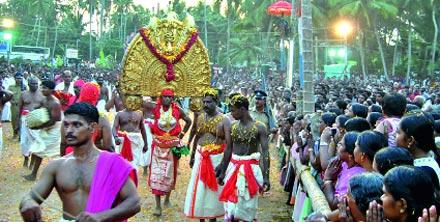
Karadikottu
Karadikottu is the first custom associated with the festival which is performed with a special drum. The artist is locally known as Panan.
Kalamkaval
Kalamkaval is a famous custom practiced in the temple premises and surrounding places during the festival. Goddess Bhadrakali is believed to search all directions for her enemy demon, Daaruka, before killing him. Devotees commemorate this legend by seeing this unique Kalamkaval. Kalamkaval is a ritual in which the head priest carries an idol on his head and performs some trance like dance until he is unconscious. During the kalamkaval, the head priest wears anklet and thiruvabharam (traditional gold ornaments of the goddess which include kappa, vanki, odyanam, paalakka mala, pichi mottu mala, muthu mala etc.). All the people believe that the priest gets the strength to continue the trance with the idol on his head due to the blessings of the Devi enshrined in the temple.
Nagaroottu
Nagaroottu is a custom performed (before “Uchabali”) to satisfy a Naga.
Uchabali
Uchabali is another custom performed during the festival. About sixty four gestures are used for the performance as in Kadhakali. Mathsyam, sampannam, chathurasramam, sarppamudra and jyothimudra are some of the main gestures used. A beautiful crown built from a coconut palm is fixed at the Uchabali site. Uchabali is performed during midnight.
Paranettu
It is believed that a fight broke out in the sky between Devi and the demon Darikan. The fight takes place on a specially constructed stage, about 100 feet high, and is fought at night known as Paranettu.
Nilathilporu
Nilathilporu which marks the conclusion of the Kaaliyoottu festival at the Vellayani Devi Temple. During the climax of this ceremony, the demon Daarika (the man with the symbolic crown in the foreground) cries and begs the goddess for mercy. Subsequently, the goddess beheads the demon.
Aaraattu
The festival, Kaliyoottu, ended with a grand procession knows as Aaraattu. During Aaraattu the Idol is cleaned using water collected from 101 pots. Aaraattu is conducted at vellayani lake. A girl from the priest family below ten years of age, along with chief priest performs the function.
Pongal or Pongala
Pongala Festival at Vellayani Devi Temple is celebrated during the Malayalam month of Meenam on the Aswathy Nakshatram (Aswini Nakshatra). Pongala is the rice cooked with jaggery, ghee, coconut as well as other ingredients in the open in small pots by women to please the Goddess.
Madhu Pooja is the special pooja performed to the Goddess.
Info on the deity – Specific to the temple deity
The presiding deity of this temple is Goddess Bhadrakali. The idol is called as Thirumudi and is about 4.5 ft tall with ornaments of authentic gold and gems decked over it. The temple also houses the deities of Lord Shiva, Lord Ganesha and Lord Nagaraja.
By Road
Vellayani is 13 km from Thiruvananthapuram. The nearest bus station is the Thiruvananthapuram Bus stand. Buses, auto-rickshaws and taxis are available almost all the time to reach the temple.
By Rail
The nearest rail head is the Thiruvananthapuram Central Railway station at a distance of 9 kms from the temple.
By Air
The nearest airport is the Thiruvananthapuram International Airport at a distance of 15 kms from the temple.
One thought on “Vellayani Devi Temple”
Leave a Reply
You must be logged in to post a comment.

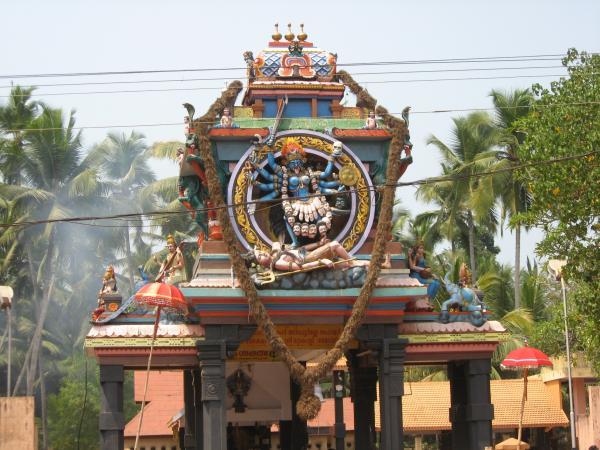
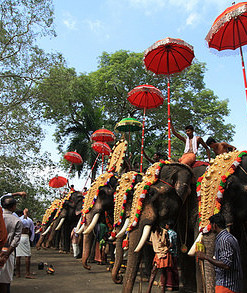


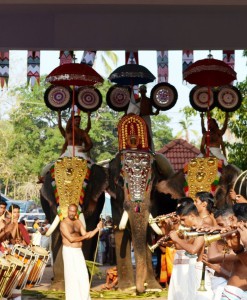
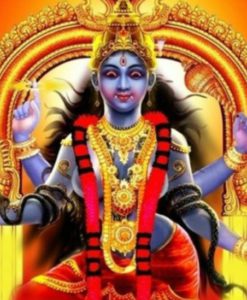

I am writing this review from the depth of my heart with all sincerity. Vellayani Amma is the only Diety who has reached out to me and drawn me close to her, my first visit to this temple was a miracle itself! The feel of being near Amma is unparalleled, there is always a warmth of comfort and assurance in just remembering Amma. The temple is mystical and it is quite different from other temple in terms of rituals and experience. I hope whoever is reading this will one day get an opportunity to come to Vellayani Devi Temple. Vellayani Ammey Sharanam!